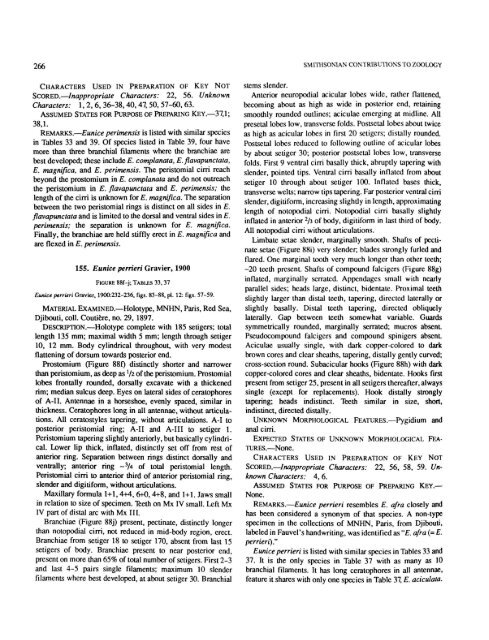A Review of the Genus Eunice - Smithsonian Institution Libraries
A Review of the Genus Eunice - Smithsonian Institution Libraries
A Review of the Genus Eunice - Smithsonian Institution Libraries
Create successful ePaper yourself
Turn your PDF publications into a flip-book with our unique Google optimized e-Paper software.
266 SMITHSONIAN CONTRIBUTIONS TO ZOOLOGY<br />
CHARACTERS USED IN PREPARATION OF KEY NOT<br />
SCORED.—Inappropriate Characters: 22, 56. Unknown<br />
Characters: 1, 2, 6, 36-38,40,47, 50, 57-60,63.<br />
ASSUMED STATES FOR PURPOSE OF PREPARING KEY.—37,1;<br />
38,1.<br />
REMARKS.—<strong>Eunice</strong> perimensis is listed with similar species<br />
in Tables 33 and 39. Of species listed in Table 39, four have<br />
more than three branchial filaments where <strong>the</strong> branchiae are<br />
best developed; <strong>the</strong>se include E. complanata, E.flavapunctata,<br />
E. magnifica, and E. perimensis. The peristomial cirri reach<br />
beyond <strong>the</strong> prostomium in E. complanata and do not outreach<br />
<strong>the</strong> peristomium in E. flavapunctata and E. perimensis; <strong>the</strong><br />
length <strong>of</strong> <strong>the</strong> cirri is unknown for E. magnifica. The separation<br />
between <strong>the</strong> two peristomial rings is distinct on all sides in E.<br />
flavapunctata and is limited to <strong>the</strong> dorsal and ventral sides in E.<br />
perimensis; <strong>the</strong> separation is unknown for E. magnifica.<br />
Finally, <strong>the</strong> branchiae are held stiffly erect in E. magnifica and<br />
are flexed in E. perimensis.<br />
155. <strong>Eunice</strong> perrieri Gravier, 1900<br />
FIGURE 88f-j; TABLES 33,37<br />
<strong>Eunice</strong> perrieri Gravier, 1900:232-236, figs. 83-88. pi. 12: figs. 57-59.<br />
MATERIAL EXAMINED.—Holotype, MNHN, Paris, Red Sea,<br />
Djibouti, coll. Coutiere, no. 29, 1897.<br />
DESCRIPTION.—Holotype complete with 185 setigers; total<br />
length 135 mm; maximal width 5 mm; length through setiger<br />
10, 12 mm. Body cylindrical throughout, with very modest<br />
flattening <strong>of</strong> dorsum towards posterior end.<br />
Prostomium (Figure 88f) distinctly shorter and narrower<br />
than peristomium, as deep as 1 /2 <strong>of</strong> <strong>the</strong> peristomium. Prostomial<br />
lobes frontally rounded, dorsally excavate with a thickened<br />
rim; median sulcus deep. Eyes on lateral sides <strong>of</strong> ceratophores<br />
<strong>of</strong> A-II. Antennae in a horseshoe, evenly spaced, similar in<br />
thickness. Ceratophores long in all antennae, without articulations.<br />
All ceratostyles tapering, without articulations. A-I to<br />
posterior peristomial ring; A-II and A-III to setiger 1.<br />
Peristomium tapering slightly anteriorly, but basically cylindrical.<br />
Lower lip thick, inflated, distinctly set <strong>of</strong>f from rest <strong>of</strong><br />
anterior ring. Separation between rings distinct dorsally and<br />
ventrally; anterior ring - 3 A <strong>of</strong> total peristomial length.<br />
Peristomial cirri to anterior third <strong>of</strong> anterior peristomial ring,<br />
slender and digitiform, without articulations.<br />
Maxillary formula 1+1,4+4, 6+0,4+8, and 1+1. Jaws small<br />
in relation to size <strong>of</strong> specimen. Teeth on Mx IV small. Left Mx<br />
IV part <strong>of</strong> distal arc with Mx III.<br />
Branchiae (Figure 88j) present, pectinate, distinctly longer<br />
than notopodial cirri, not reduced in mid-body region, erect.<br />
Branchiae from setiger 18 to setiger 170, absent from last 15<br />
setigers <strong>of</strong> body. Branchiae present to near posterior end,<br />
present on more than 65% <strong>of</strong> total number <strong>of</strong> setigers. First 2-3<br />
and last 4-5 pairs single filaments; maximum 10 slender<br />
filaments where best developed, at about setiger 30. Branchial<br />
stems slender.<br />
Anterior neuropodial acicular lobes wide, ra<strong>the</strong>r flattened,<br />
becoming about as high as wide in posterior end, retaining<br />
smoothly rounded outlines; aciculae emerging at midline. All<br />
presetal lobes low, transverse folds. Postsetal lobes about twice<br />
as high as acicular lobes in first 20 setigers; distally rounded.<br />
Postsetal lobes reduced to following outline <strong>of</strong> acicular lobes<br />
by about setiger 30; posterior postsetal lobes low, transverse<br />
folds. First 9 ventral cirri basally thick, abruptly tapering with<br />
slender, pointed tips. Ventral cirri basally inflated from about<br />
setiger 10 through about setiger 100. Inflated bases thick,<br />
transverse welts; narrow tips tapering. Far posterior ventral cirri<br />
slender, digitiform, increasing slightly in length, approximating<br />
length <strong>of</strong> notopodial cirri. Notopodial cirri basally slightly<br />
inflated in anterior 2 /3 <strong>of</strong> body, digitiform in last third <strong>of</strong> body.<br />
All notopodial cirri without articulations.<br />
Limbatc setae slender, marginally smooth. Shafts <strong>of</strong> pectinate<br />
setae (Figure 88i) very slender, blades strongly furled and<br />
flared. One marginal tooth very much longer than o<strong>the</strong>r teeth;<br />
-20 teeth present. Shafts <strong>of</strong> compound falcigcrs (Figure 88g)<br />
inflated, marginally serrated. Appendages small wilh nearly<br />
parallel sides; heads large, distinct, bidentatc. Proximal teeth<br />
slightly larger than distal teeth, tapering, directed laterally or<br />
slightly basally. Distal teeth tapering, directed obliquely<br />
laterally. Gap between teeth somewhat variable. Guards<br />
symmetrically rounded, marginally serrated; mucros absent.<br />
Pseudocompound falcigers and compound spinigcrs absent.<br />
Aciculae usually single, wilh dark copper-colored to dark<br />
brown cores and clear sheaths, tapering, distally gently curved;<br />
cross-section round. Subacicular hooks (Figure 88h) with dark<br />
copper-colored cores and clear sheaths, bidentate. Hooks first<br />
present from setiger 25, present in all setigers <strong>the</strong>reafter, always<br />
single (except for replacements). Hook distally strongly<br />
tapering; heads indistinct. Teeth similar in size, short,<br />
indistinct, directed distally.<br />
UNKNOWN MORPHOLOGICAL FEATURES.—Pygidium and<br />
anal cirri.<br />
EXPECTED STATES OF UNKNOWN MORPHOLOGICAL FEA-<br />
TURES.—None.<br />
CHARACTERS USED IN PREPARATION OF KEY NOT<br />
SCORED.—Inappropriate Characters: 22, 56, 58, 59. Unknown<br />
Characters: 4,6.<br />
ASSUMED STATES FOR PURPOSE OF PREPARING KEY.—<br />
None.<br />
REMARKS.—<strong>Eunice</strong> perrieri resembles E. afra closely and<br />
has been considered a synonym <strong>of</strong> that species. A non-type<br />
specimen in <strong>the</strong> collections <strong>of</strong> MNHN, Paris, from Djibouti,<br />
labeled in Fauvel's handwriting, was identified as "£. afra (= E.<br />
perrieri)."<br />
<strong>Eunice</strong> perrieri is listed with similar species in Tables 33 and<br />
37. It is <strong>the</strong> only species in Table 37 with as many as 10<br />
branchial filaments. It has long ceratophores in all antennae,<br />
feature it shares with only one species in Table 37, E. aciculata.
















